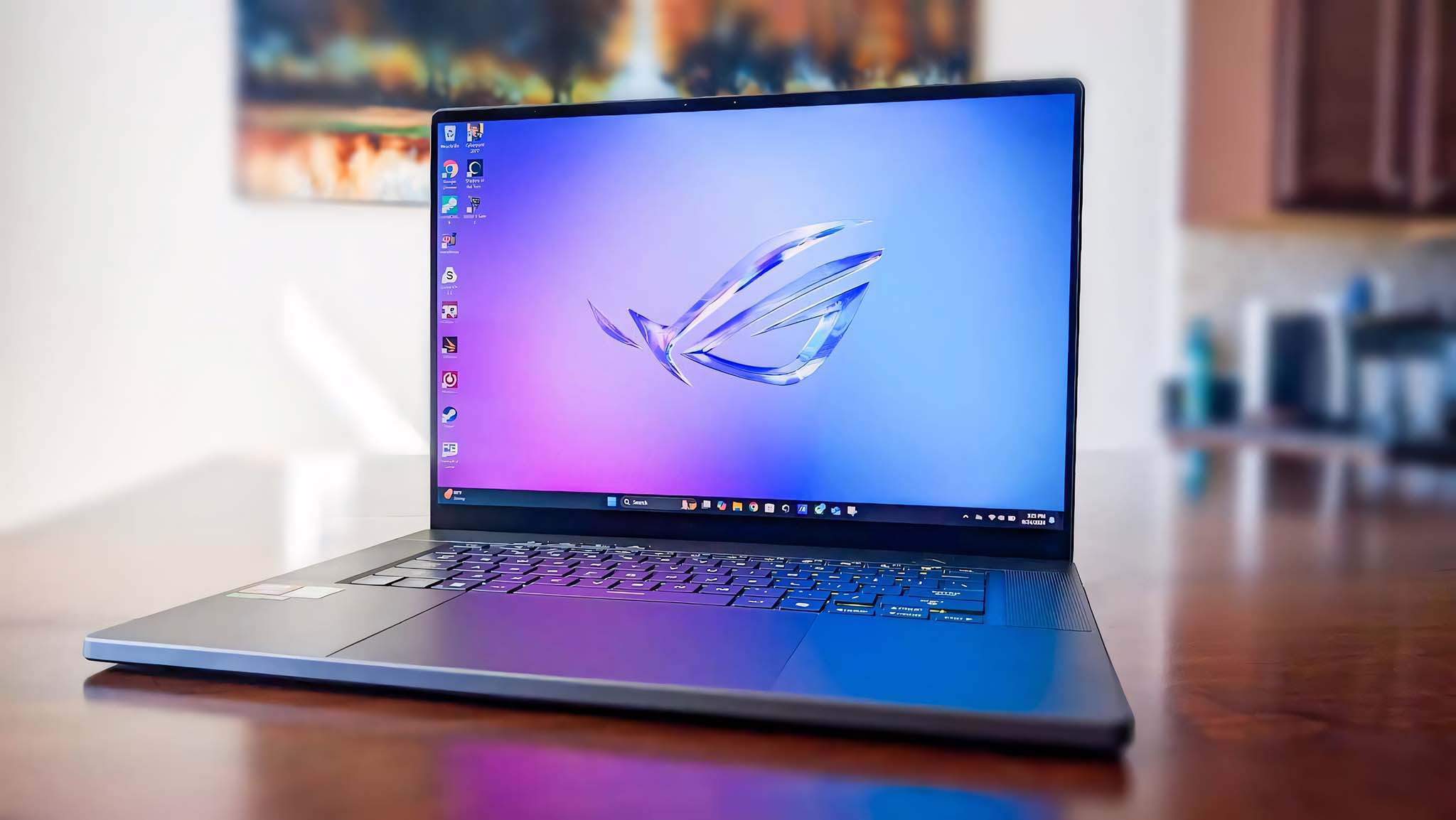
As a seasoned tech enthusiast who’s been around the block a few times, I must say the ASUS ROG Zephyrus G16 (2024) GA605 has definitely caught my eye. With its sleek design that blends elegance with gaming prowess, it’s unlike any other laptop I’ve seen in my years of tech journalism.
In the earlier part of the year, I completed a review on the ASUS ROG Zephyrus G16 (2024) GU605, praising its Intel Core Ultra AI processor. Recently, ASUS has unveiled an AMD Ryzen AI 9HX variant of this very same laptop, maintaining the original name but appending a GA605 model number. Since then, I’ve been eager to compare the two models, so for the past fortnight, I’ve been immersed in gaming sessions, running different benchmark tests, and using it for work purposes.
What’s the difference between this AMD-powered laptop and one with an Intel processor, and should we consider purchasing it? To help make an informed decision, let’s explore its performance characteristics and key features.
ASUS Zephyrus G16 (2024): Price and specs

Pricing & specifications highlights
- As usual with mid-to-high-tier gaming laptops, this model is relatively pricey, especially when you choose one of the higher-tier configurations. It has a starting price of $1,899.99 and goes up from there.
- The specific configuration I reviewed has a $2,299.99 MSRP.
- There are fewer configuration options with the AMD model than there are with the Intel model.
- Price rating: 3.5/5
When it comes to the graphics processing unit (GPU), you get the choice between the NVIDIA RTX 4060 L or the more powerful RTX 4070 L, which aren’t the most powerful options on the market but great overall. In terms of memory, there are three options: 8GB, 16GB, and 32GB. If you plan to play a lot of graphically demanding games, then going higher with memory should help the laptop run more smoothly. Meanwhile, you can choose between going with either a 1TB or a 2TB SSD. Unless you play games non-stop and need to keep those files saved locally, then the 1TB should be a good fit for most people.
It’s important to mention that the Intel GU605 variant of the Zephyrus G16 provides a wider selection of RTX 40-Series GPUs compared to the AMD GA605 model, with the former reaching up to an incredibly powerful RTX 4090 L, while the latter maxes out at an RTX 4070 L.
I’ve recently reviewed the ASUS Zephyrus G16 GA605, which retails for $2,299.99. This model comes equipped with an RTX 4070 L graphics card, 32GB of RAM, and a 1TB SSD. ASUS distributes this product to over 110 countries globally, and it’s also available at popular retailers such as Best Buy, Walmart, and Amazon.
Recommended configuration
ASUS Zephyrus G16 (2024): Design and build

Build quality and design highlights
- While not the sleekest-looking gaming laptop on the market, the Zephyrus G16 (2024) GA605 looks nice overall and offers a sturdy build.
- There are a good number of USB ports and even a full SD reader, but it’s missing an RJ45 port, which is odd for a gaming laptop.
- Fingerprints don’t show up that much on the casing.
- Design rating: 4/5
Instead of sporting the flashy, often over-the-top designs common in many gaming laptops, the Zephyrus G16 sets itself apart with a more refined aesthetic that can seamlessly blend into a professional environment. However, if you’re a fan of the bold, RGB-heavy looks typically found in gaming laptops, this model might not be your cup of tea. While it may not have the most sleek exterior, it boasts a robust build and maintains an attractive overall appearance.
The lid boasts a slender profile, adorned with diagonal white lighting at its peak – commonly referred to as Slash lighting. I’ll delve deeper into this Slash lighting in my upcoming review, but for now, let me just say that it contributes to and detracts from the laptop’s overall visual appeal. In the meantime, the dark gray casing is an attractive shade, and the aluminum body does a fairly effective job of concealing fingerprint smears.
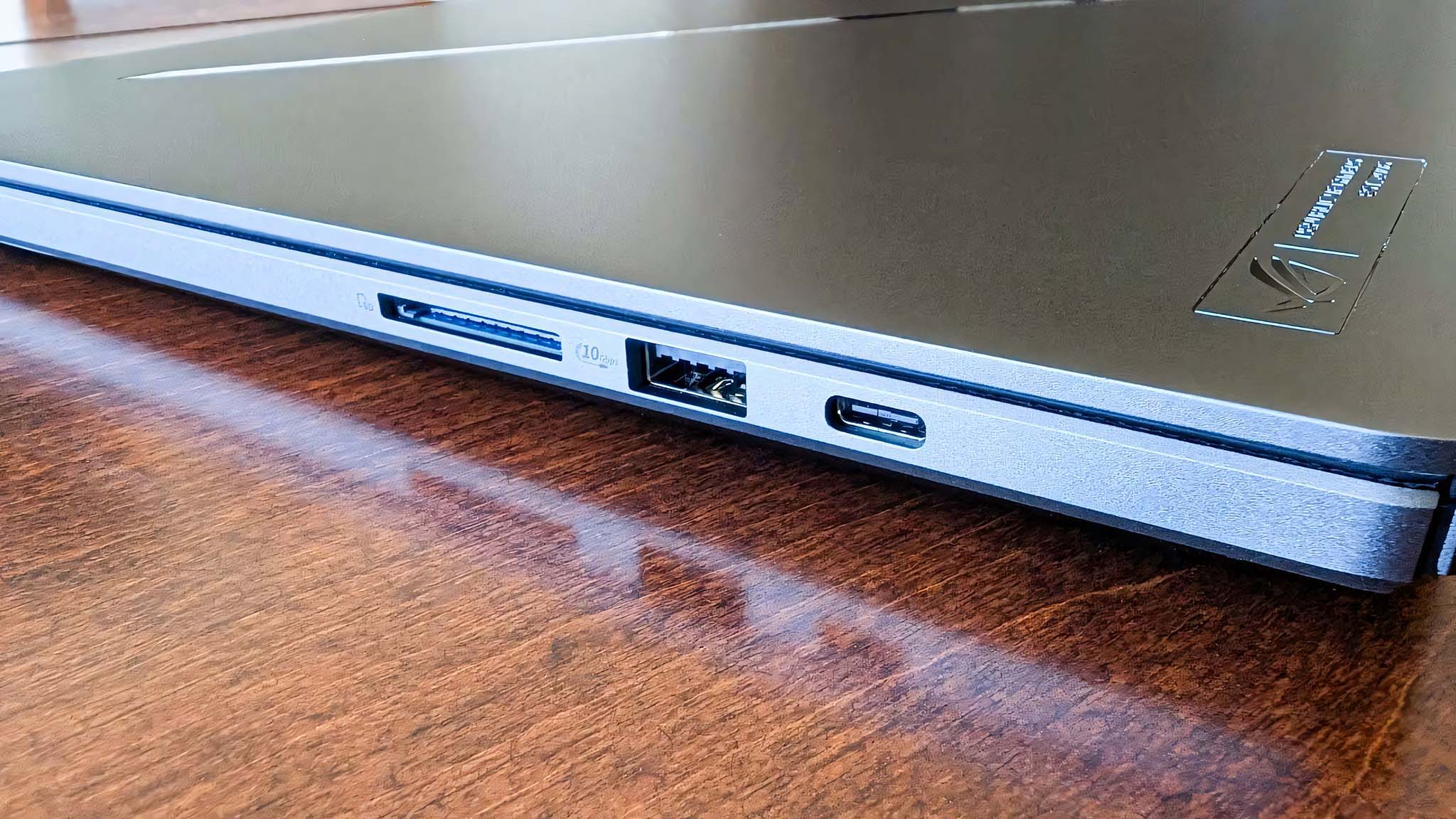

In summary, the Zephyrus G16 boasts a decent variety of ports, except for one key omission: an RJ45 (Ethernet) port. On either side of this laptop, you’ll find a full-sized SD card reader, four USB ports (two USB-A and two USB-C), an HDMI port, a power port, and a 3.5mm headphone jack. If you plan to use this laptop for online gaming, it might be wise to invest in a top-tier Thunderbolt 4 hub with an integrated Ethernet port, to ensure a more reliable connection compared to Wi-Fi.
ASUS Zephyrus G16 (2024): Software and lighting

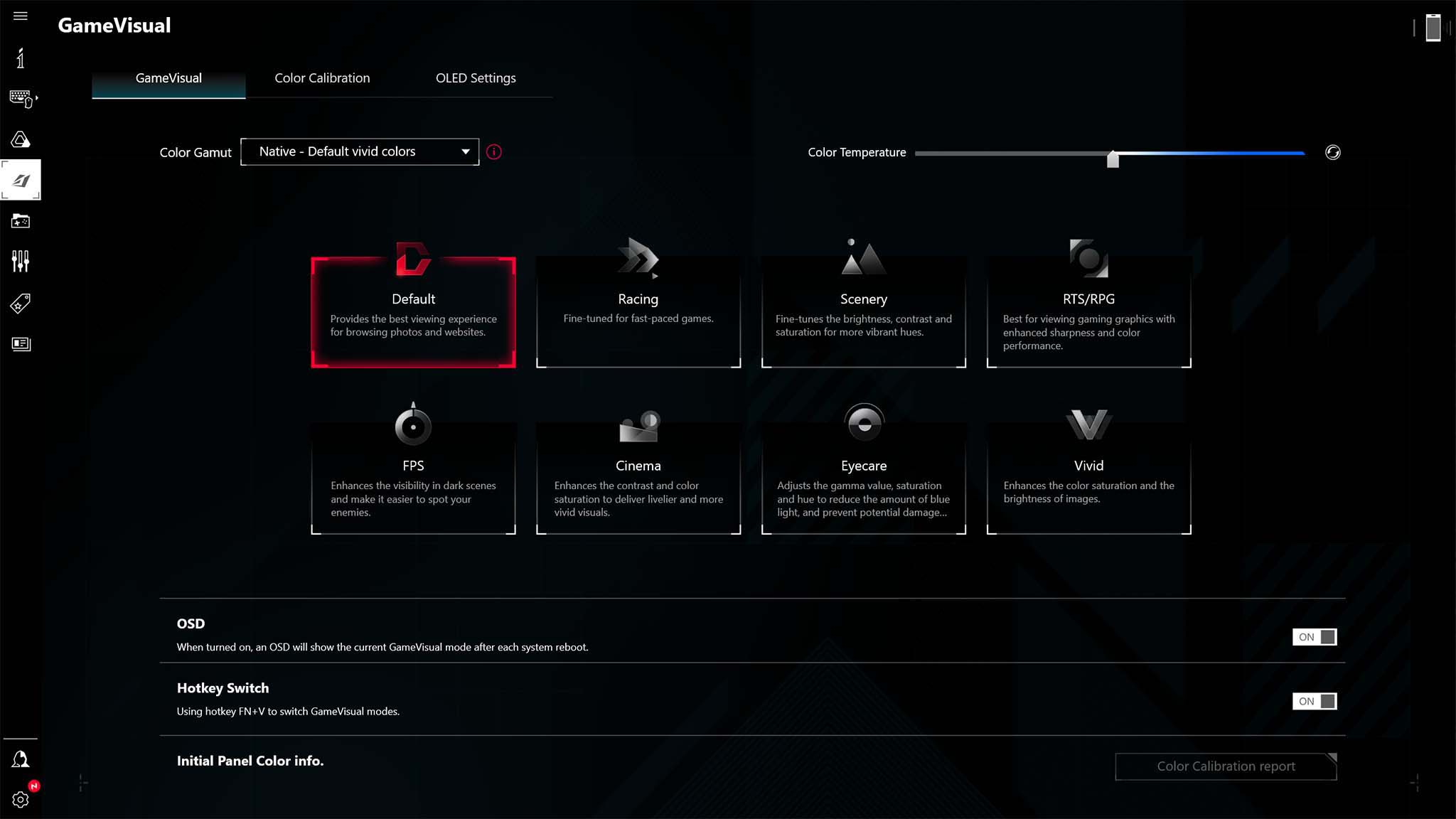
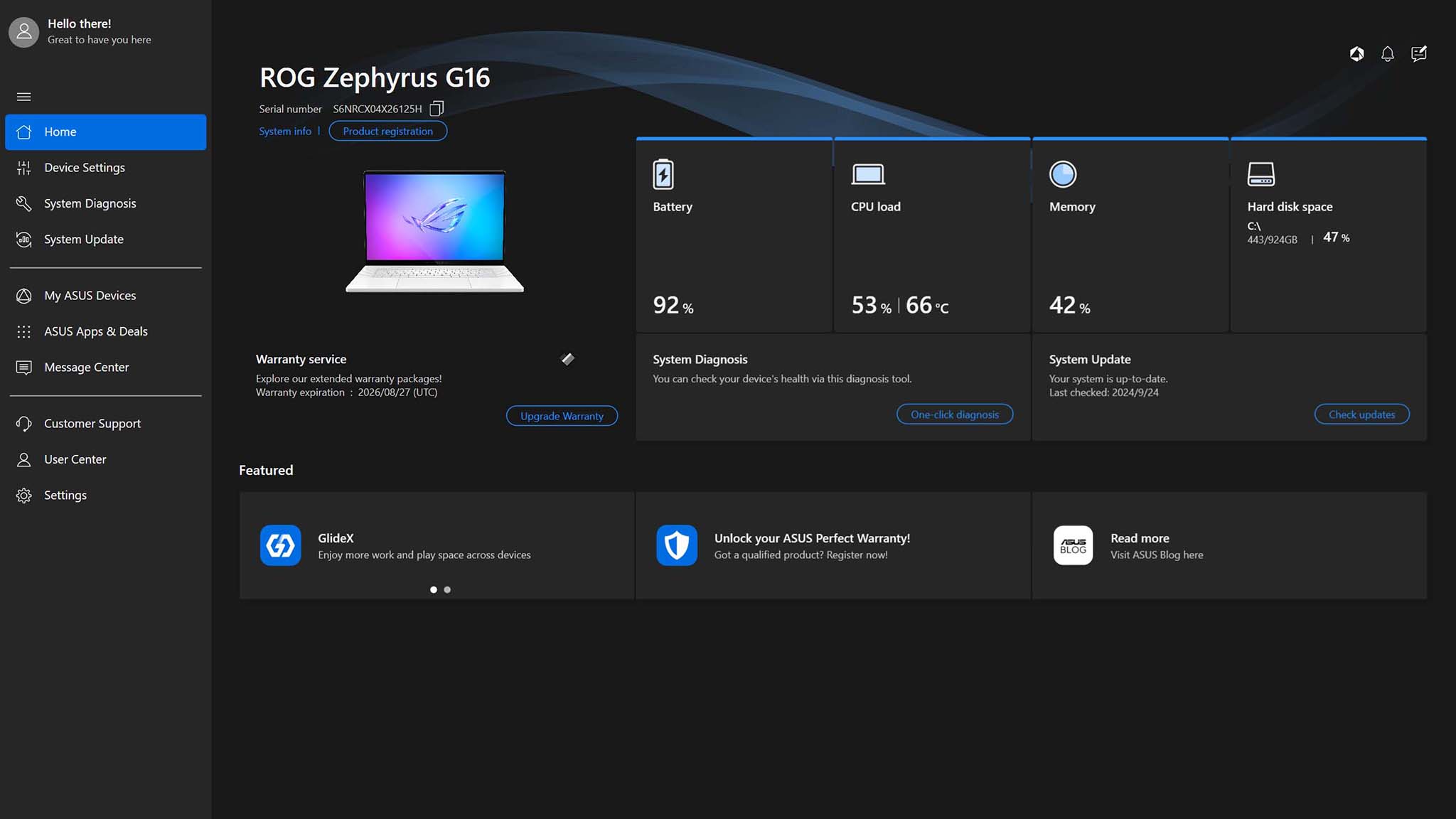

Software and RGB lighting highlights
- This laptop comes with a few programs, but the ones you’ll interact with most are MyASUS and the gaming-focused Armoury Crate.
- MyASUS allows you to run system diagnostics, adjust settings, find updates, and contact customer support.
- Armoury Crate gives a more in-depth look at system performance while allowing users to set up Macros, adjust lighting, choose different game modes, and even launch their games.
- Effects and the brightness level of the Slash lighting on the lid can be customized or turned off completely.
- Design rating: 3.5/5
Just like other leading laptop manufacturers, ASUS preloads specific software on its devices to enhance the user’s experience. On the Zephyrus model, the key software includes MyASUS for system management tasks and Armoury Crate, a software primarily designed for gamers.
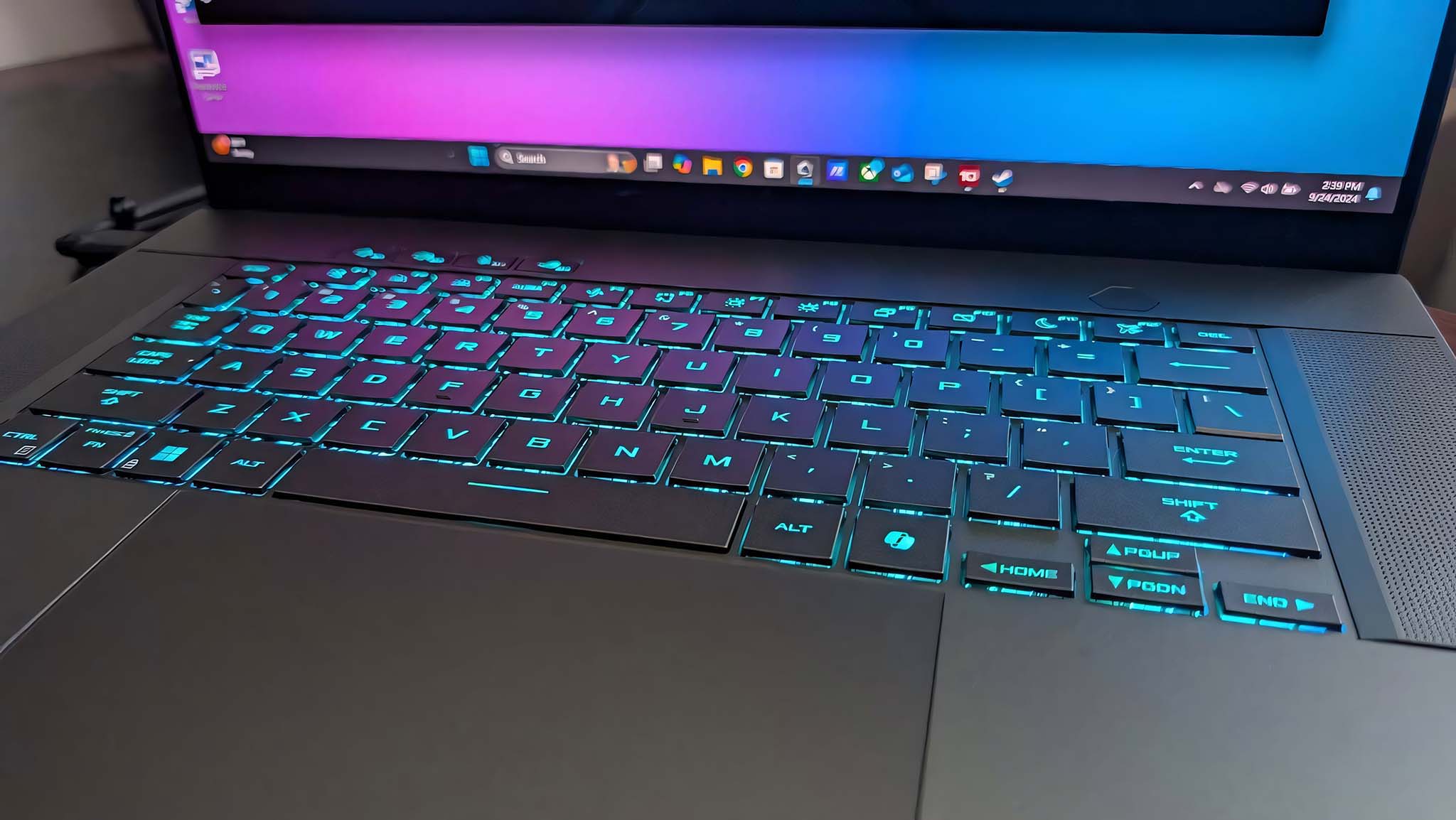


Between these two software applications, you’ll frequently switch between their various configurations as they each offer unique features. For example, MyASUS expedites customer support and system diagnostics, while Armoury Crate showcases system performance, adjusts lighting settings, and lets you create macros. Although both programs boast user-friendly designs and an abundance of useful options, Armoury Crate can be a bit cumbersome to navigate due to its numerous submenus.
Regarding the lighting, the diagonal slash on the cover appears solely in white, but there are multiple options for effects within Armoury Crate that you can select from. However, I find many of these effects to be fast-paced and unattractive, so I usually opt for a plain line on the Slash bar or simply disable it altogether.
Additionally, you can customize the keyboard backlighting within Armoury Crate, offering a range of colors instead of the standard white. You’re also able to modify effect speeds and brightness levels. I find it useful that Armoury Crate allows me to control the lighting based on battery status; I can decide whether the lighting is active when the device is not plugged in, in sleep mode, or running on battery power.
ASUS Zephyrus G16 (2024): Display
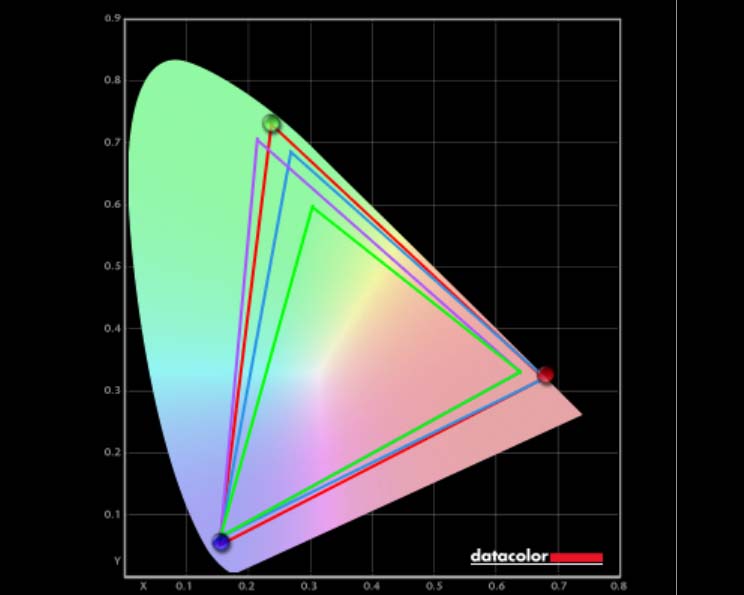
Display highlights
- This OLED display offers beautiful color and contrast to show off games to great effect.
- The ASUS ROG Zephyrus G16 (2024) GA605 OLED panel produced 100% of sRGB, 96% of AdobeRGB, and 100% of P3 in a color gamut test.
- Game visuals are smooth thanks to G-Sync support, a 240Hz refresh rate, and 0.2ms response time.
- It would be nicer if the screen got brighter than 400 nits, but the fact that it produces true black allows colors to stand out better than non-OLED displays.
- ASUS OLED Care helps prevent burn-in, while Flicker-Free Dimming helps protect your eyes.
- Display rating: 5/5
Currently, OLED displays are generally considered top-tier for gaming because of their impressive features such as high refresh rates, swift response times, extensive color range, and capability to produce authentic black. Notably, this type of panel is compatible with G-Sync, boasts a rapid 240Hz refresh rate, and offers a quick 0.2ms response time – all of which contribute significantly to delivering outstanding motion clarity. The ability to display true black on these panels means that when they are supposed to show black, pixels actually turn off rather than appearing grey. This allows neighboring colors to appear more vibrant in comparison. Furthermore, this panel supports HDR and offers a sharp 2.5K resolution, ensuring game visuals remain crisp and visually appealing.
Upon taking out my colorimeter for a color gamut assessment on the Zephyrus screen, it didn’t come as a shock to find that it delivered an excellent 100% of sRGB, 96% of Adobe RGB, and 100% of P3. The display offers stunning visuals for games, boasting high contrast, vibrant color shifts, and sharp details.
During my examination, I utilized a device called a colorimeter to perform a luminance and contrast check on the display. ASUS claims that this screen can reach an impressive 500 nits, however, during my tests it maxed out at approximately 400 nits, which is considerably dimmer than we expected. To add to the issue, the screen tends to be quite reflective, making it advisable to use the laptop in locations that are not close to bright lights or windows. In my personal experience, I found it challenging to see certain games while seated in my kitchen near the sliding glass door, especially when the sunlight was streaming through. It wasn’t until I closed the blinds that I could comfortably view the games again.
On OLED displays, there’s a risk of permanent damage known as screen burn-in. To safeguard against this issue, the ASUS Zephyrus G16 comes equipped with ASUS OLED Care features in Armoury Crate. This technology is designed to prevent any images from etching onto the screen. By default, it also includes a screensaver, but you can disable it in Windows settings if desired.
Similarly, there’s a control for Flicker-Free OLED Dimming within Armoury Crate as well. This feature aims to alleviate eye strain by minimizing screen flickering on OLED displays. However, it may not work efficiently at lower brightness settings. In fact, if you reduce the brightness substantially, your laptop might prompt you to rest your eyes, especially if you’re experiencing any discomfort.
ASUS Zephyrus G16 (2024): Performance and gaming

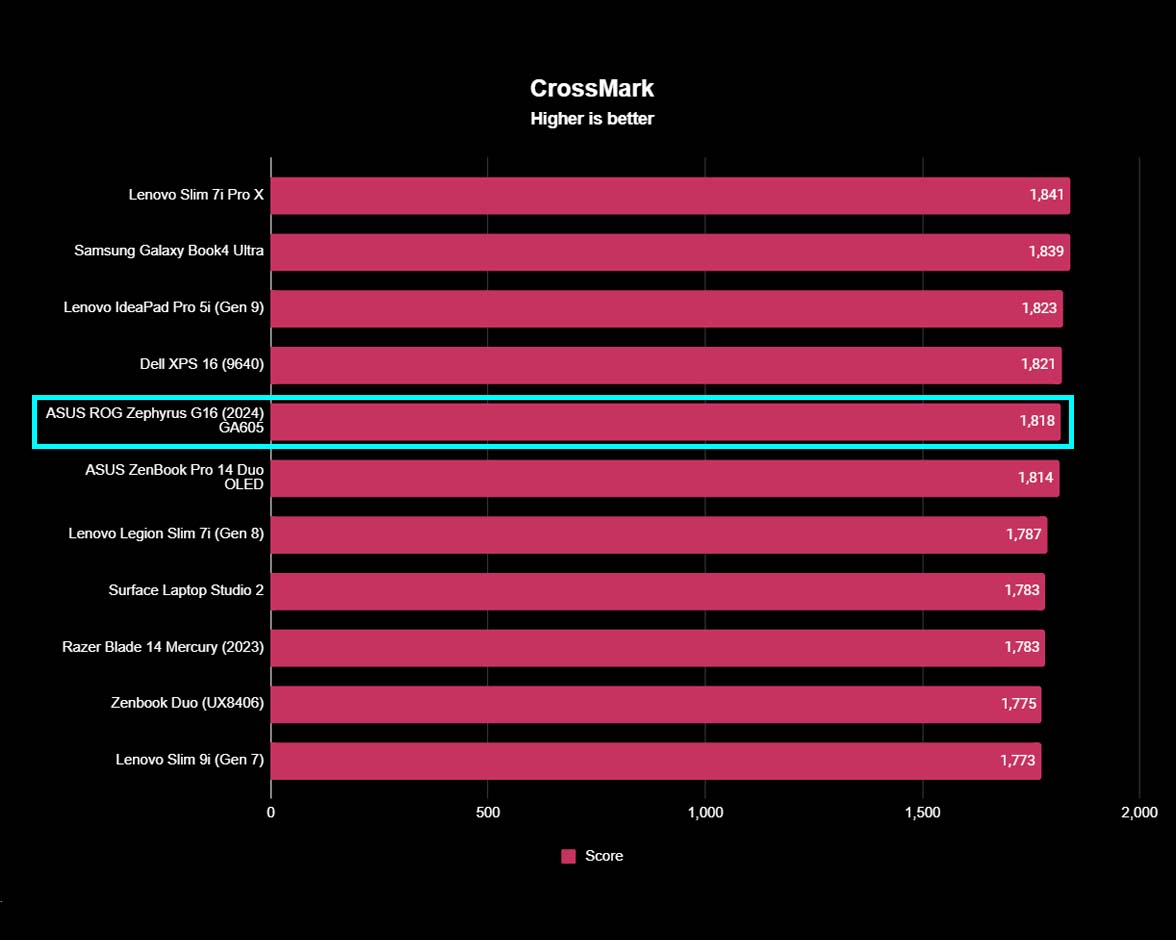


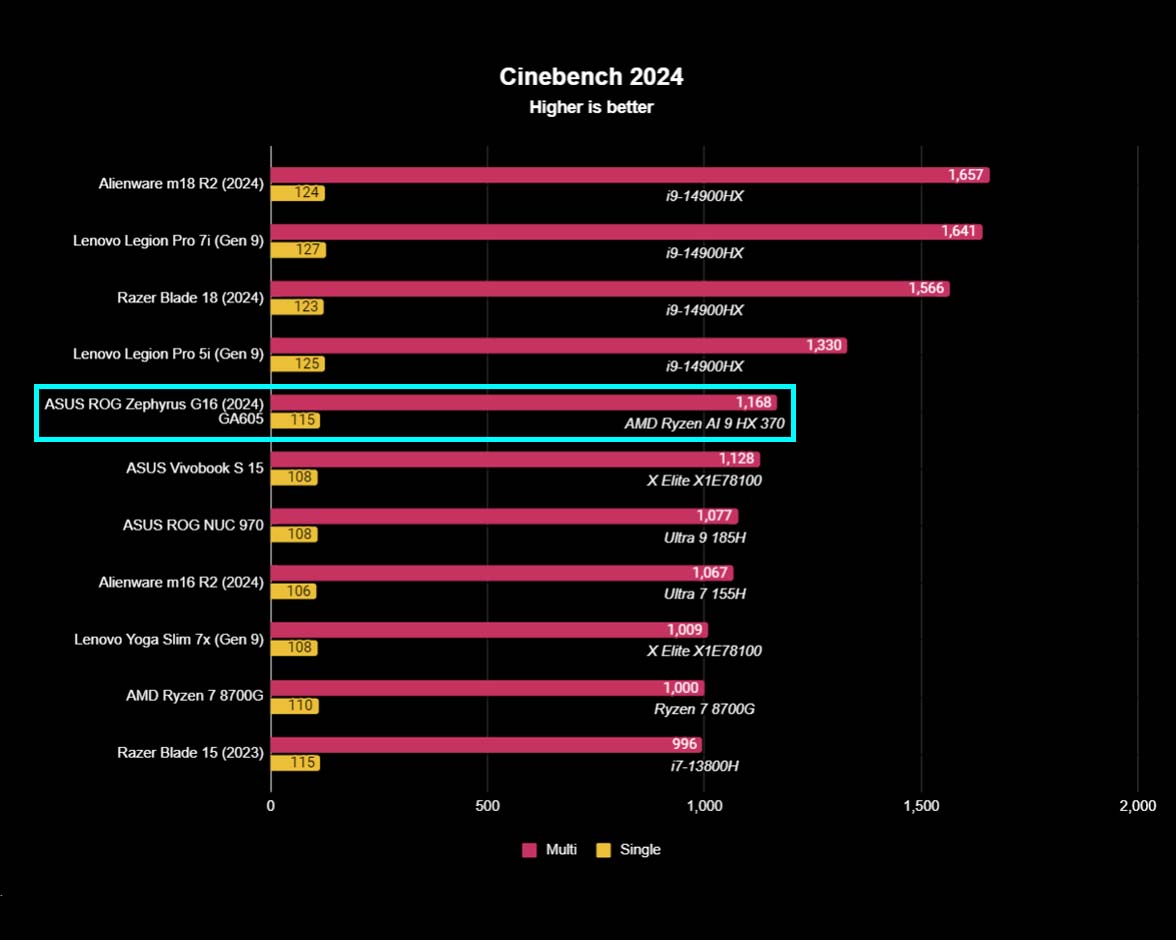
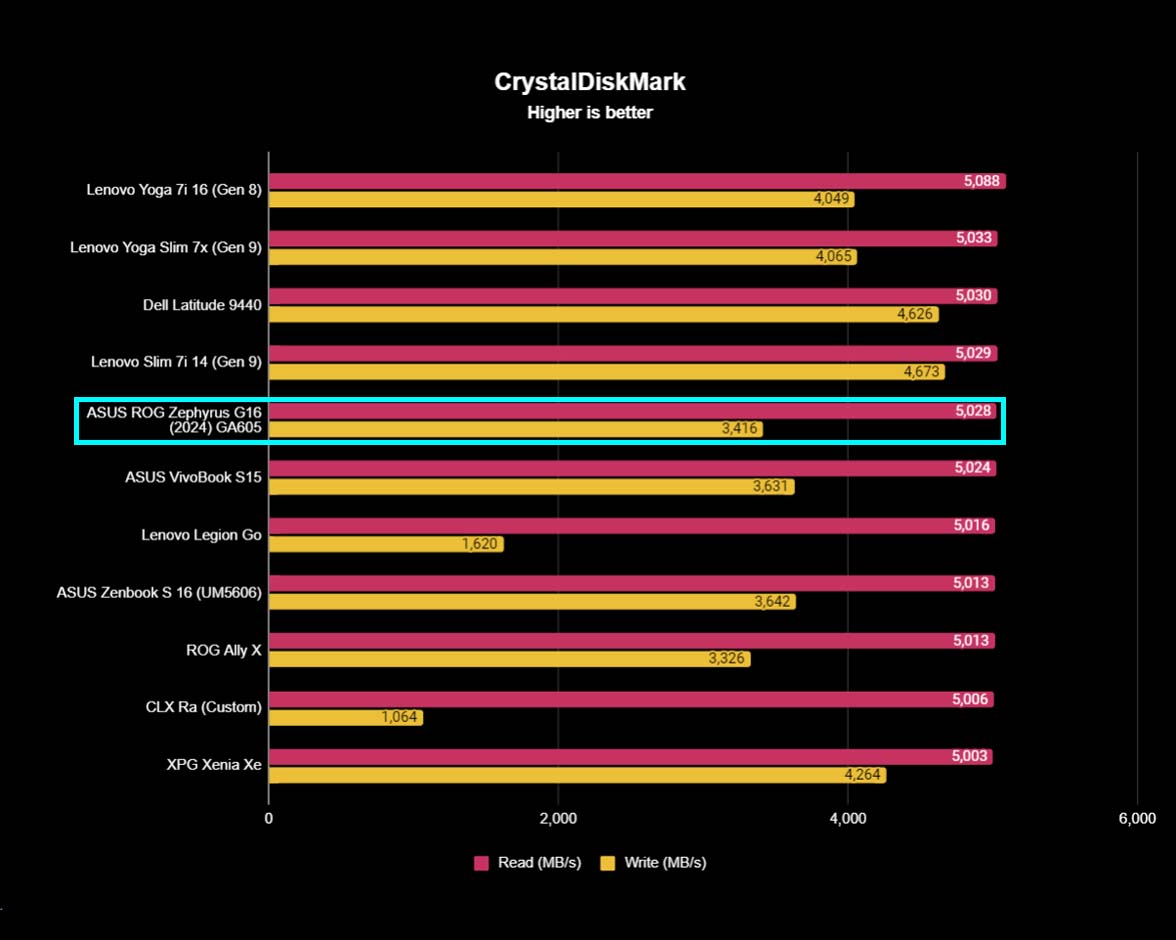
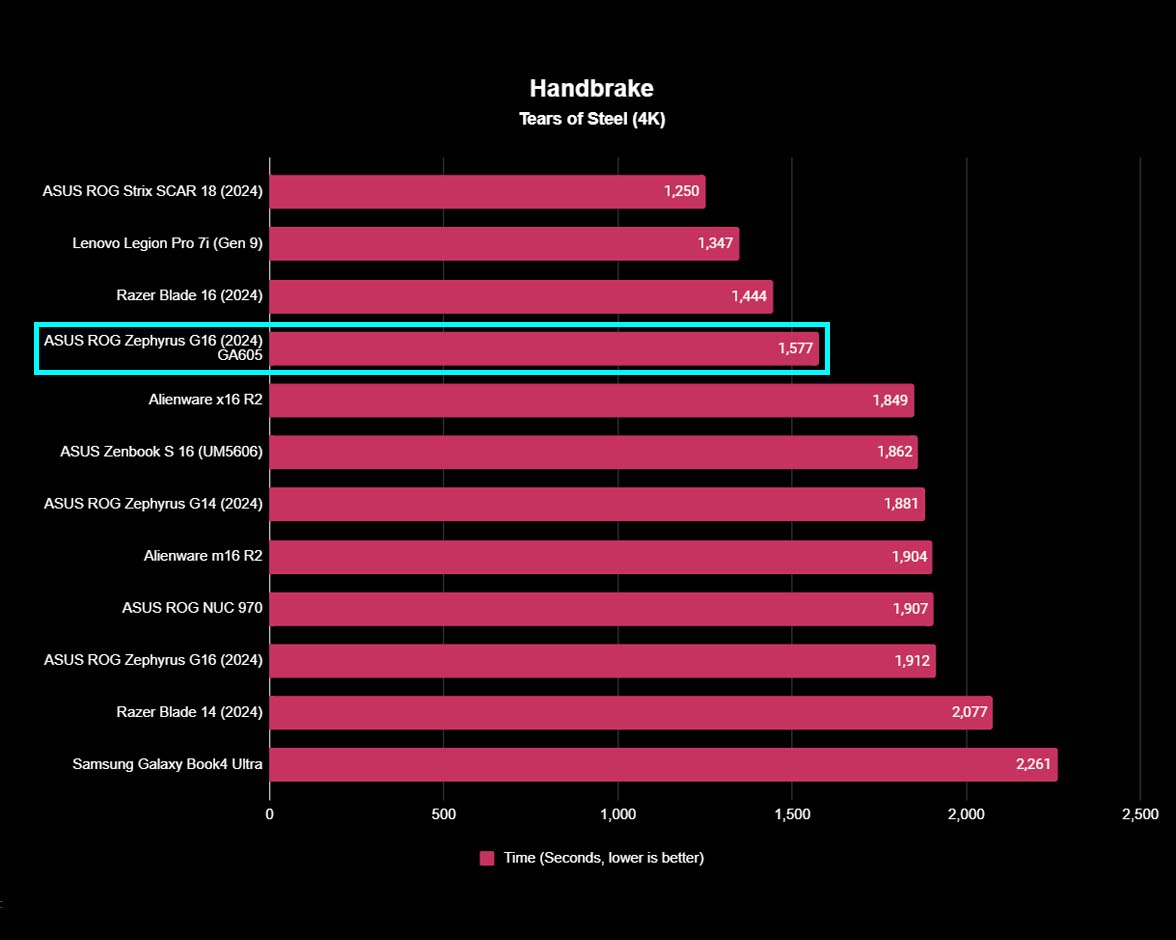
Performance & gaming highlights
- Overall, the Zephyrus G16 GA605 offers solid every day and gaming performance.
- The AMD model of the Zephyrus sometimes performed lower and sometimes performed higher than the Intel model.
- Fans never get too loud, and the laptop does a great job of keeping itself decently cool.
- Performance rating: 4/5
As an analyst, after spending a week immersed in gaming and computer work on the Zephyrus G16 GA605, I can confidently say it operates exceptionally well, providing an engaging user experience. To gather more concrete data about its performance, I subjected this AMD-equipped model to our standard battery of benchmark tests. Intriguingly, I compared its results with those from the Intel-powered Zephyrus G16 GU605 that I had tested previously. There were slight discrepancies, but ultimately, both machines showcased impressive performance given their respective configurations.
As a passionate tech enthusiast, I recently put the AMD AI CPU’s 3D rendering capabilities to the test by running a Cinebench R24 benchmark. Impressively, it achieved a multi-core score of 1,168 and a single-core score of 115. Earlier this year, when I tested the Intel Zephrus G16, I used Cinebench R23, so I ran this new laptop on that older version as well for comparison purposes with the Intel Zephrus G16.
As a tech-savvy individual, I’ve got some exciting benchmark results to share! The AMD variant blew me away with its multi-core score of 21,809 and single-core score of 940. On the other hand, the Intel version delivered a lower multi-core score of 18,399 but an impressive single-core score of 1,862. For gaming enthusiasts like myself, the multi-core score takes center stage, and in this case, the AMD model clearly outshone the Intel model.

As a researcher, I proceeded to assess the CPU performance using Geekbench 6. The AMD Ryzen AI 9 HX 370 delivered an impressive multi-core score of 15,259 and a single-core score of 2,889. Unfortunately, during the time of testing, I couldn’t retrieve any numbers from the Intel Zephryus G16 for comparison as the program was not functioning properly. However, this AMD score is remarkably high, surpassing all other AI CPUs we’ve tested so far, and it even outperforms many non-AI CPUs in the same category.
To gauge the graphics performance of the Zephyrus G16 equipped with its GPU, I ran a 3DMark’s GPU Time Spy benchmark. The AMD variant, powered by an RTX 4070 L, scored 10,730 points, while the Intel version boasting an RTX 4080 L naturally delivered a slightly higher score of 13,249. In essence, this performance is satisfactory. It’s not the highest scores we’ve witnessed from an RTX 4070 L GPU, but it’s also not the lowest. In summary, its performance aligns with expectations.
During the CrystalDiskMark SSD test, the GA605 equipped with AMD performed at a read speed of 5,028 MB/s and a write speed of 3,416 MB/s. Interestingly, this is significantly lower than the GU605, which has an Intel processor, boasting a read speed of 7,063 MB/s and a write speed of 5,226 MB/s. Moreover, these results fall short of our expectations for a gaming laptop’s SSD performance. This implies that the AMD model may not be as swift when it comes to retrieving data or saving files compared to its Intel counterpart.
To evaluate overall system performance, I utilized the Crossmark benchmark and found that the AMD-equipped Zephyrus outperformed the Intel Zephyrus with a slightly lower score of 1,783, earning an impressive 1,818 points. Essentially, this indicates that the hardware components in the AMD model function harmoniously well together, demonstrating excellent performance for any laptop.
On our AI-powered PC, I conducted a Procyon Windows ML benchmark, and surprisingly, the AMD Ryzen AI 9 HX 370 achieved a record-breaking score of 126 – the best performance we’ve observed from an AI CPU so far. This remarkable speed suggests that this enhanced AMD processor excels at handling local AI tasks effectively. However, whether or not it benefits your laptop usage depends on the specific software and games you intend to run.
Buttery smooth gaming performance
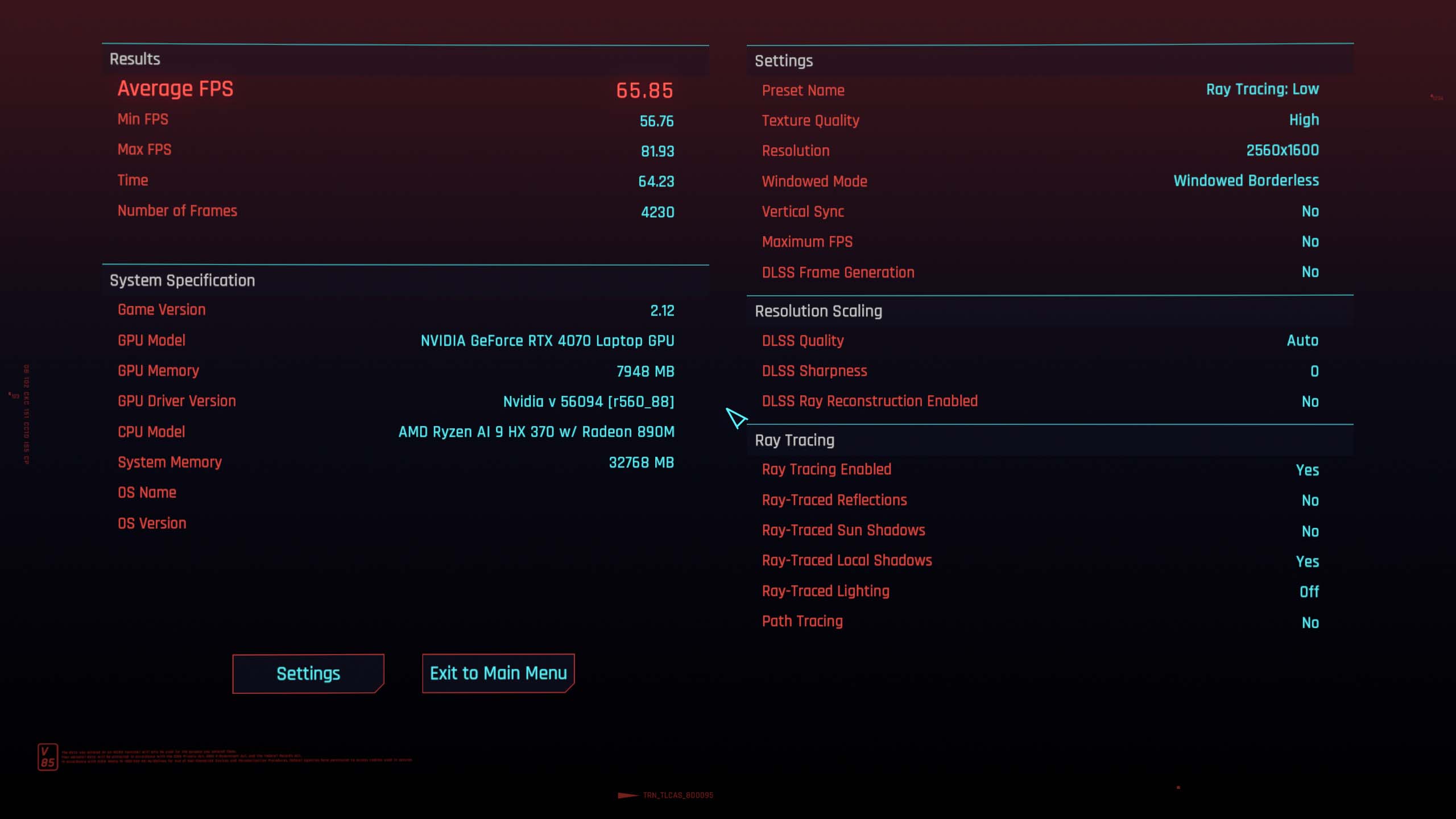
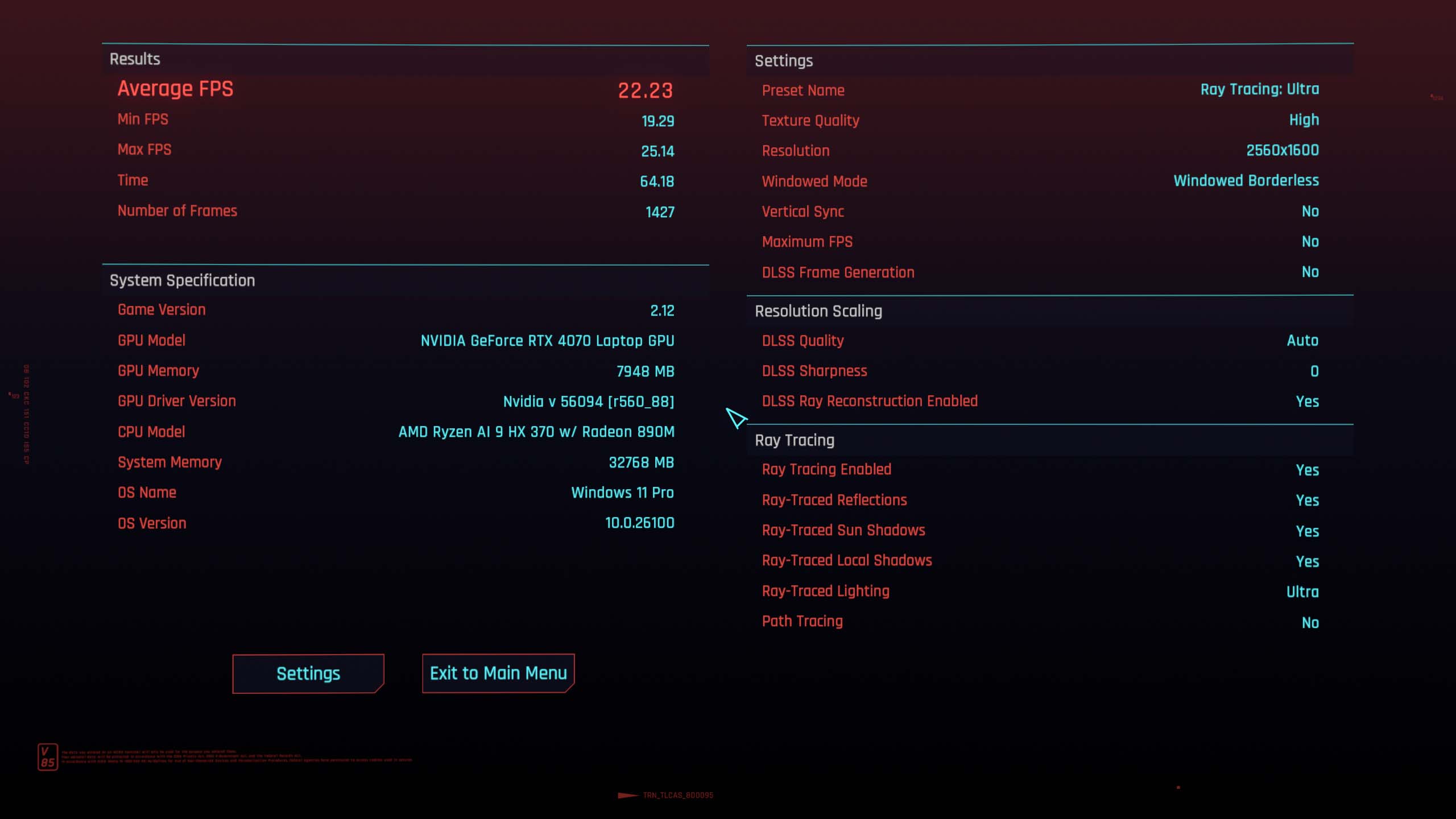

It’s clear we’ve looked at overall benchmark scores, but I’m curious about its gaming performance – specifically, how does the Zephyrus fare in games like Cyberpunk 2077? To test this, I installed the most recent NVIDIA GeForce Game Ready Drivers and ran the game for several minutes. Inside the game, I activated the built-in benchmark and ran some tests.
For fun, I cranked up the graphics to the extreme Ray Tracing: Overdrive level, enabled both Path Tracing and Ray Reconstruction, and then ran the test. Remarkably, the laptop maintained an average of 27.18 frames per second. These settings are taxing for many laptops, but even though it fell short of the 30 FPS console standard, it clearly demonstrates that this is a potent gaming machine. However, it’s worth noting that the Intel model I tested earlier achieved an average 36.48 FPS in the same Ray Tracing: Overdrive test, which is more impressive.
Thermals and fan noises
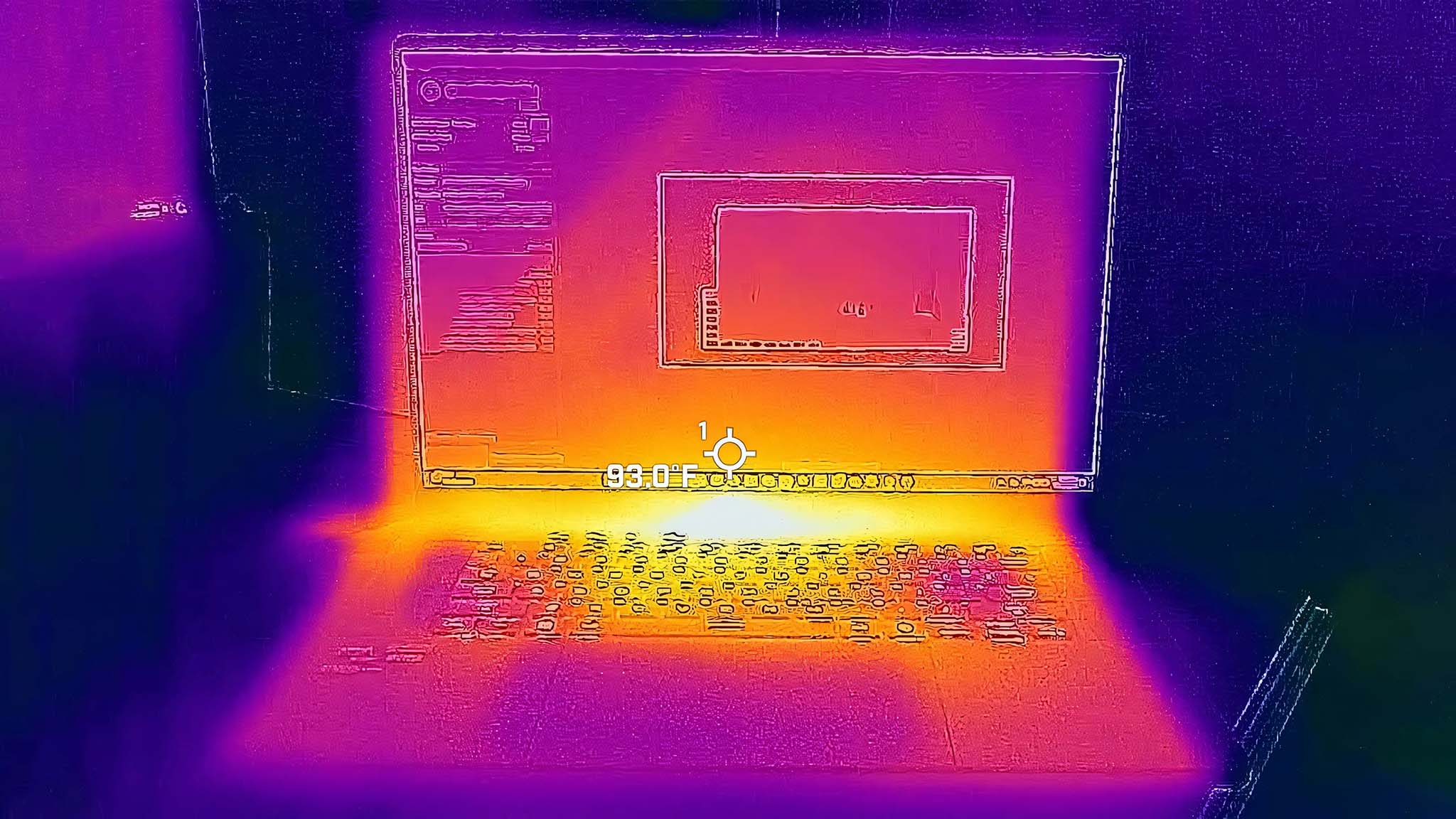
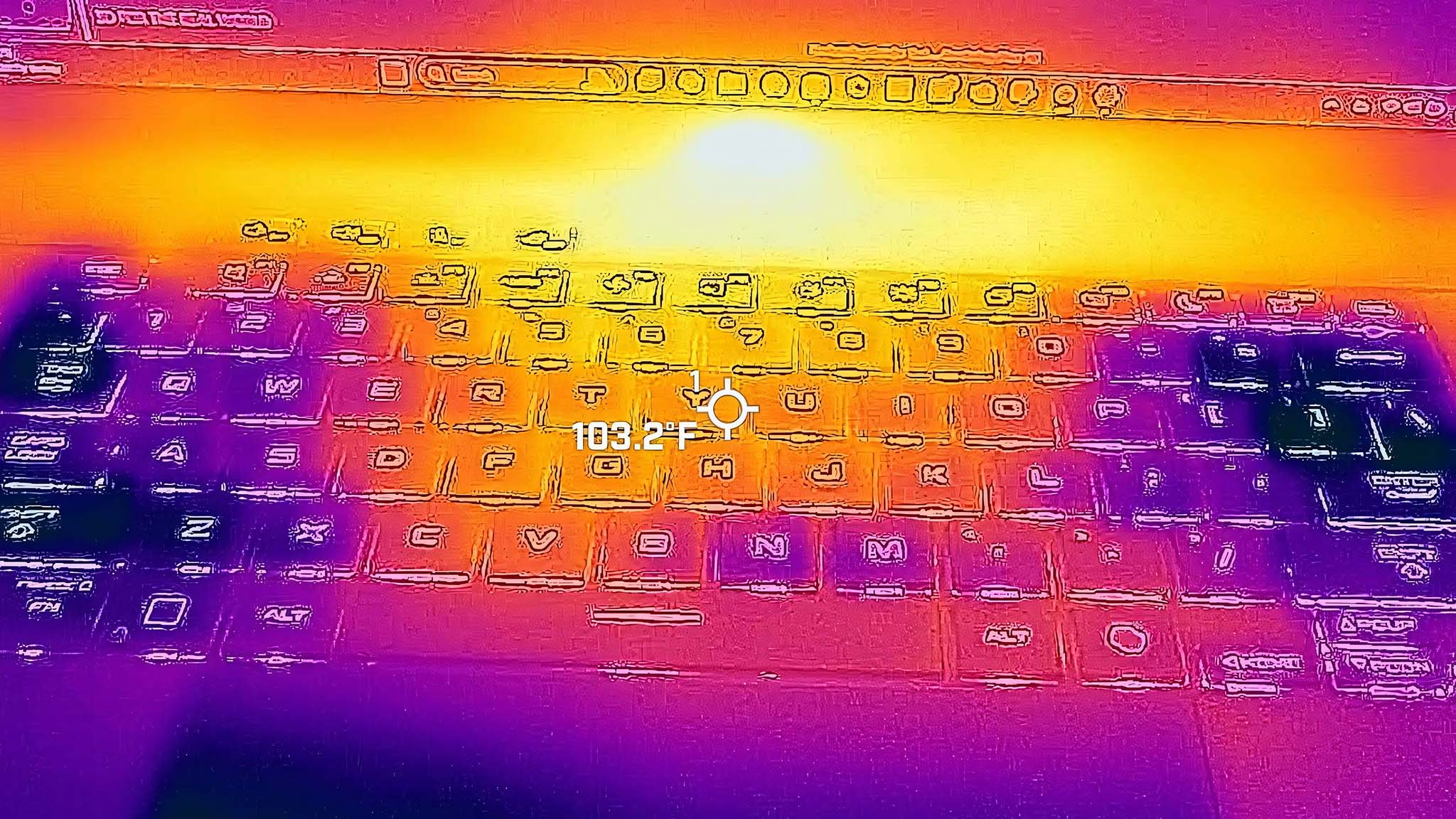

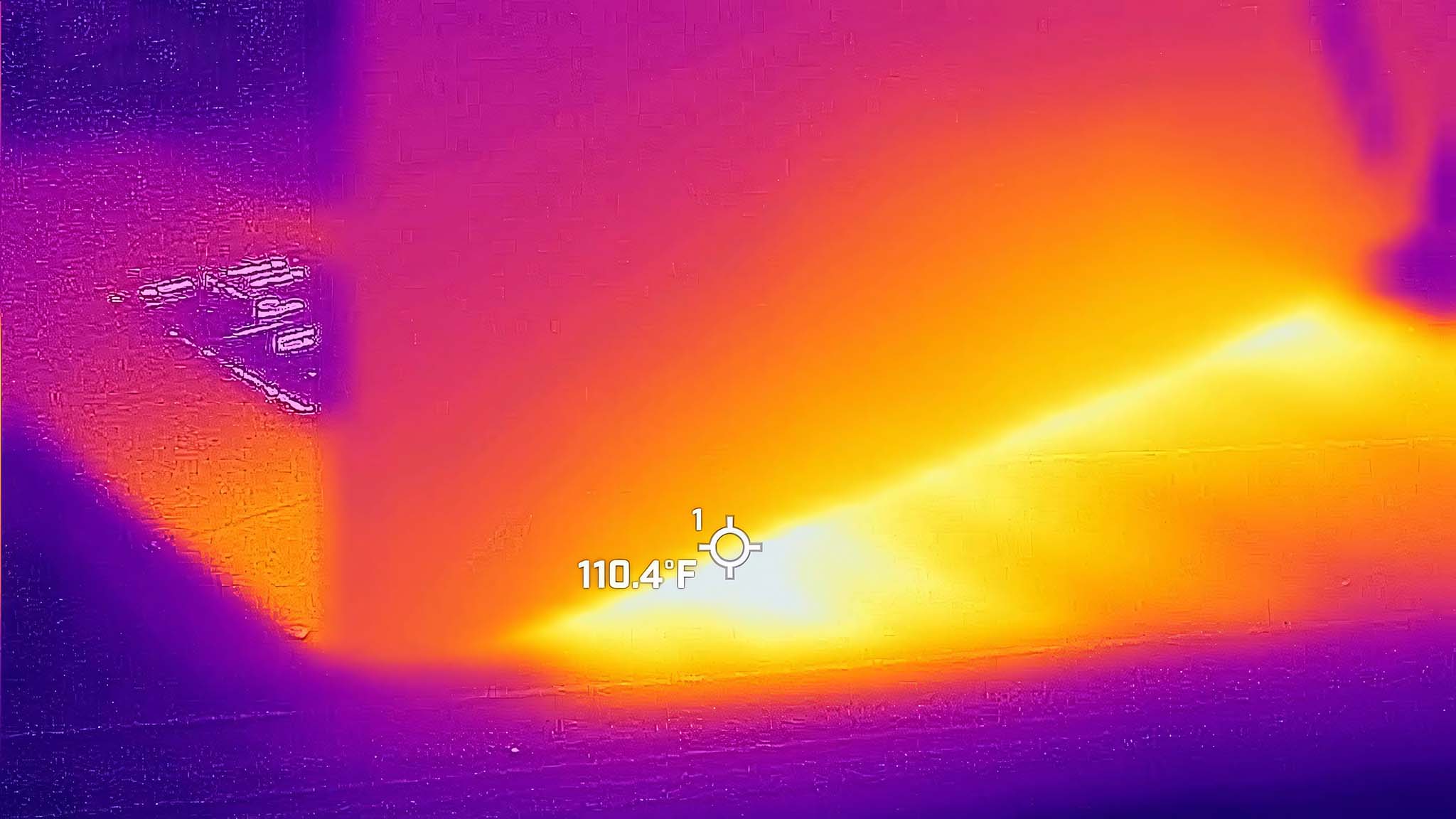
To gauge the cooling performance of the laptop, I conducted a 20-minute CPU stress test using Cinebench and subsequently employed a thermal camera to measure temperatures. The hottest spot on the laptop was identified as the area below the display, directly above the keyboard, reaching 122 degrees F (~50 degrees C). The keyboard’s center became moderately warm but never uncomfortably hot, peaking at 103 degrees F (~39 degrees C). Conversely, the vent area at the back was measured at 110 degrees F (~43 degrees C). Notably, other laptops may experience warming near the ports, but this area remained relatively cool. Additionally, I observed that the bottom of the laptop didn’t heat up excessively for use on my lap.
While conducting the CPU stress test, I additionally measured the noise level with a decibel meter and found that the fans peaked at 49.2 decibels. Although this isn’t extremely loud, it is a sound you will pick up on while using the Zephyrus G16 laptop.
ASUS Zephyrus G16 (2024): Battery life
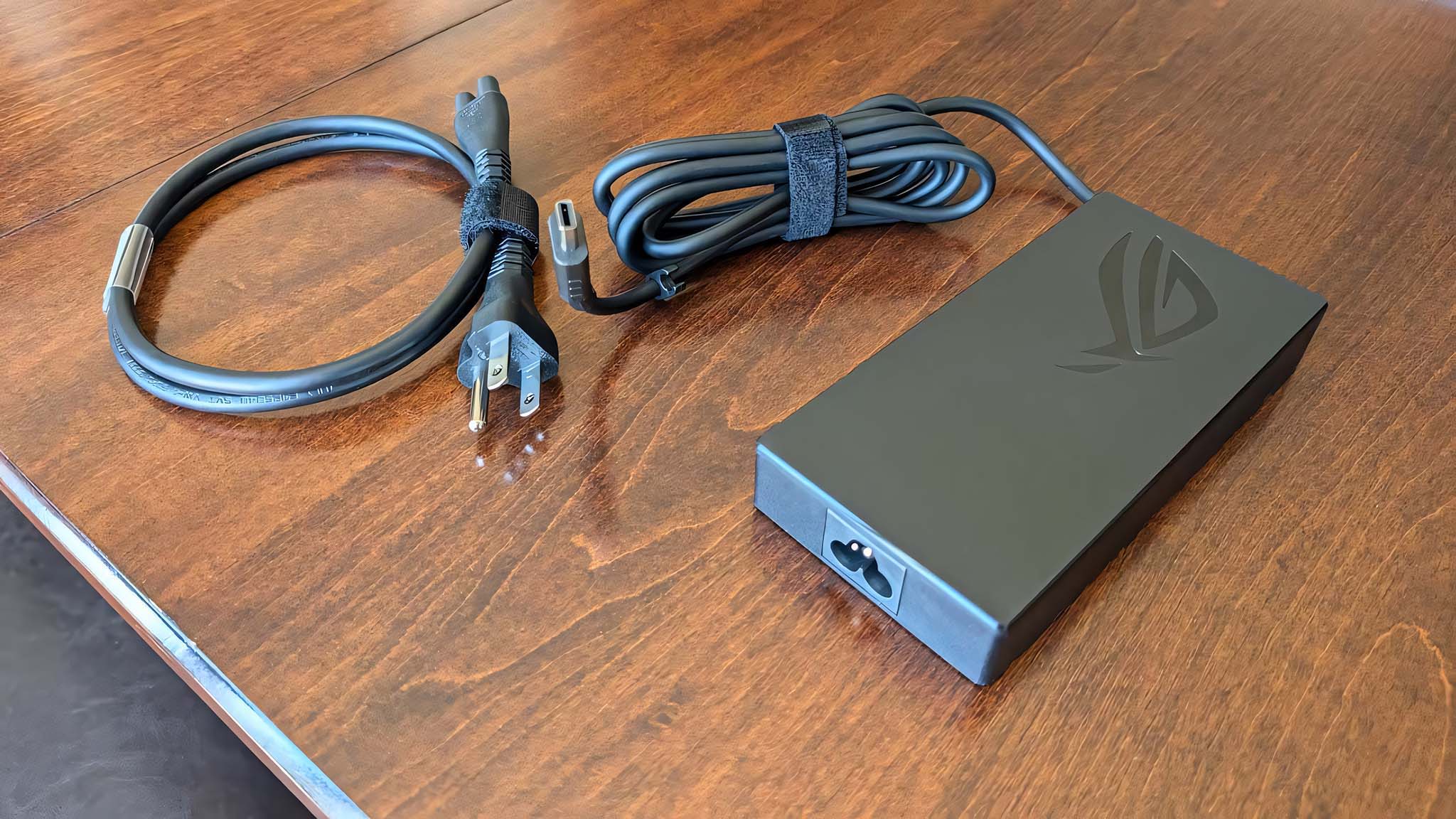
Battery highlights
- The laptop only lasts about four hours and 27 when it’s used for simple tasks like browsing the internet and watching shows in Silent mode.
- When playing demanding video games, the laptop only lasts about an hour in Performance mode.
- This Zephyrus G16 can be charged with a compatible USB-C cable, but it comes with a DCI cable in the box.
- Battery rating: 3/5
The unfortunate truth with gaming laptops is that they usually have pretty short battery life; the same is true of the Zephyrus G16 GA605. When doing simple tasks like browsing the web, streaming shows, and running basic software in Silent mode, the laptop can last for up to four hours and 27 minutes before running out of juice. This is pretty short and isn’t even long enough to last a full day of work or school without needing a recharge.
However, battery life is even worse when running intensive video games in Performance mode. As an example, when playing something like Cyberpunk 2077 or Baldur’s Gate 3 with the laptop on performance mode and the screen at roughly 200 nits brightness, the battery runs out within an hour and four minutes. Obviously, these shorter run times, though expected, aren’t great. You will want to use the Zephyrus while close to an outlet in order to get a full day’s use out of it.
Regarding charging, the Zephyrus G16 comes equipped with a DCI charging cable that fits into the DCI port located on the right side of the laptop. It’s important to note that this device can also be charged using a suitable USB-C cable; however, for efficient charging, the cable should be able to deliver at least 100W of power output.
ASUS Zephyrus G16 (2024): Keyboard and touchpad
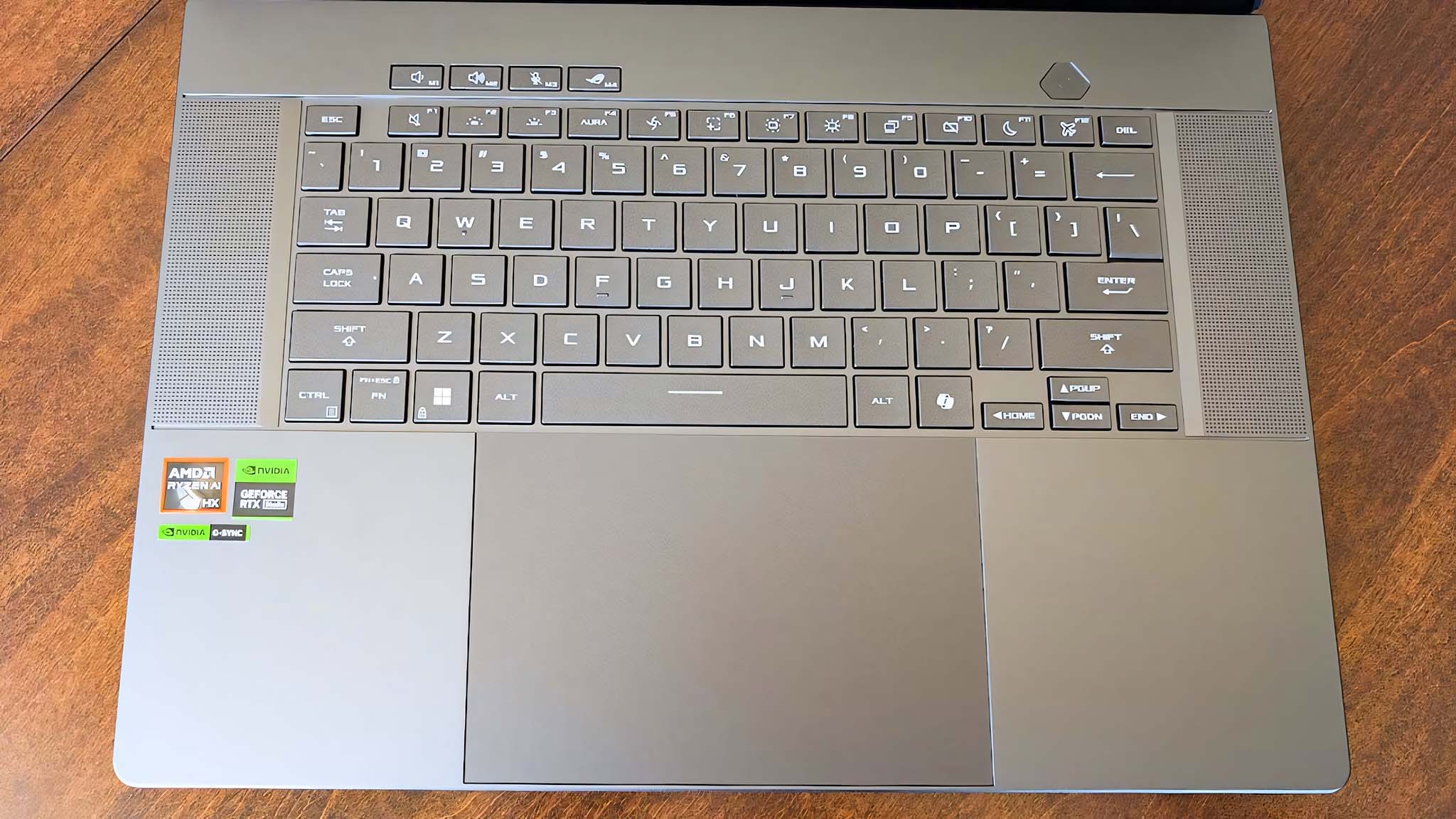
Keyboard and touchpad highlights
- Keys are nicely spaced and feel good to press down on.
- The touchpad is relatively large and easy to navigate, and it doesn’t feel like it’s taking away from the keyboard space.
- There are plenty of helpful Function key shortcuts, a Copilot button, and four keys above the main keyboard for easy access.
- Keyboard and touchpad rating: 4/5
ASUS does a good job of spacing out the keys on the keyboard so that my fingers have plenty of room to move around. As is typical with ASUS’ gaming laptops, the letters displayed on these keys have a futuristic font that some might like and others might not. The RGB colors come through well and provides a fun gaming vibe to the laptop. Overall, the keys press down with little resistance and feel good to use.
This keyboard boasts an intuitive design, offering more than just essential functions. Given that it’s an official Copilot+ PC, it’s not unexpected to find a Copilot button conveniently placed near the arrow keys. A swift press of this button launches Windows’ built-in AI assistant. Additionally, the function row provides easy and speedy access to features like muting, adjusting keyboard backlight, applying keyboard effects, switching performance modes, activating the Snipping Tool, adjusting display brightness, opening the Display Settings menu, toggling the touchpad, putting the device to sleep, and enabling Airplane mode.

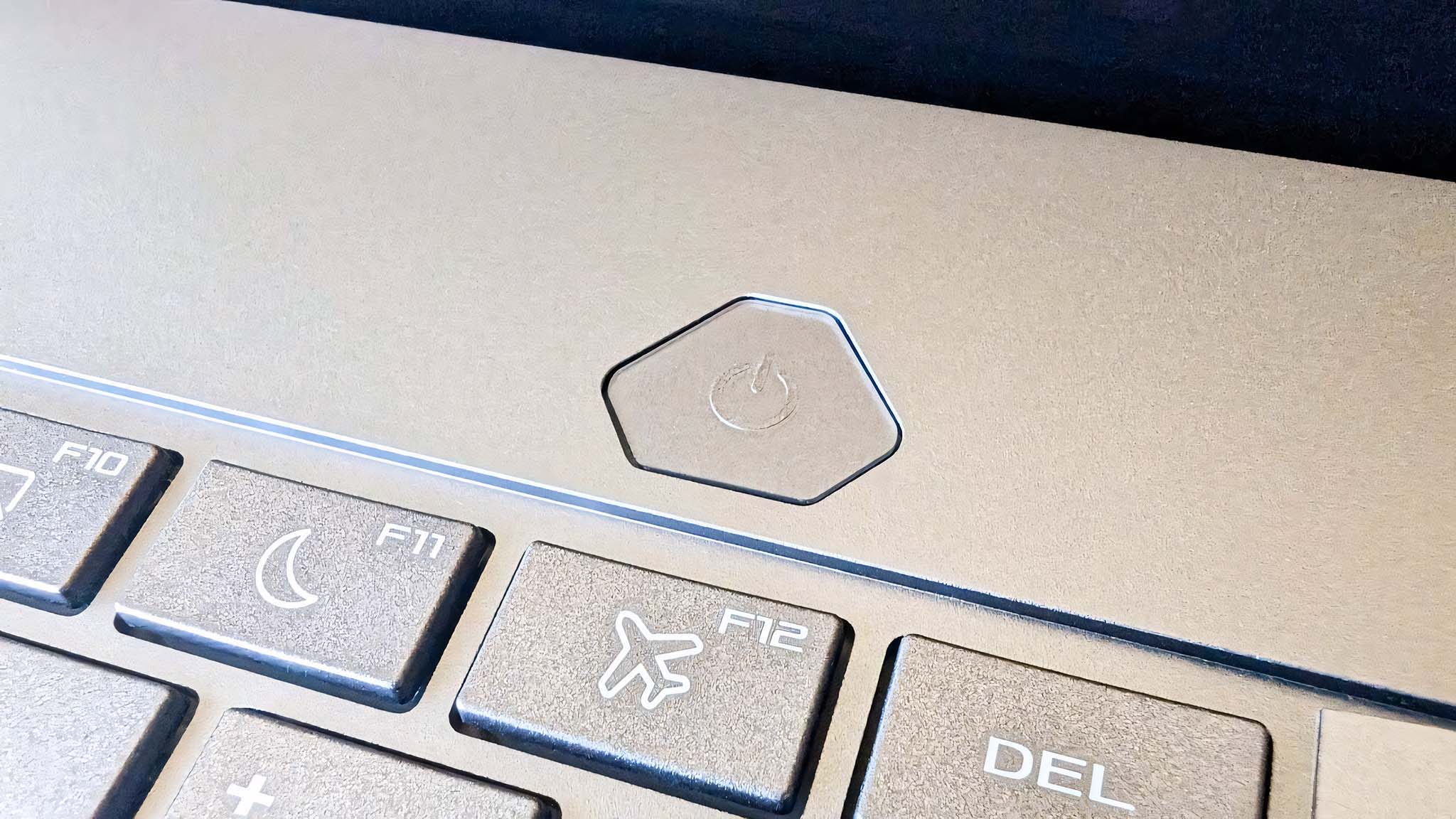
Above your keyboard’s left side, you’ll find four buttons: Decrease volume, Increase volume, a Mute/Unmute microphone switch, and a shortcut to launch Armoury Crate. It’s convenient to have these settings and options at your fingertips. On the other hand, the prominent power button is situated above the keyboard’s right side, a position that minimizes accidental presses.
In recent laptop testing, I’ve seen quite a few touchpads that were on the smaller side, which is why I was very happy with the relatively large size of the Zephyrus G16 GA605’s touchpad. It’s about 6-inches long by 4-inches tall, and it makes it easy to navigate around the various programs and menus that I interact with.
ASUS Zephyrus G16 (2024): Camera, mic, and audio
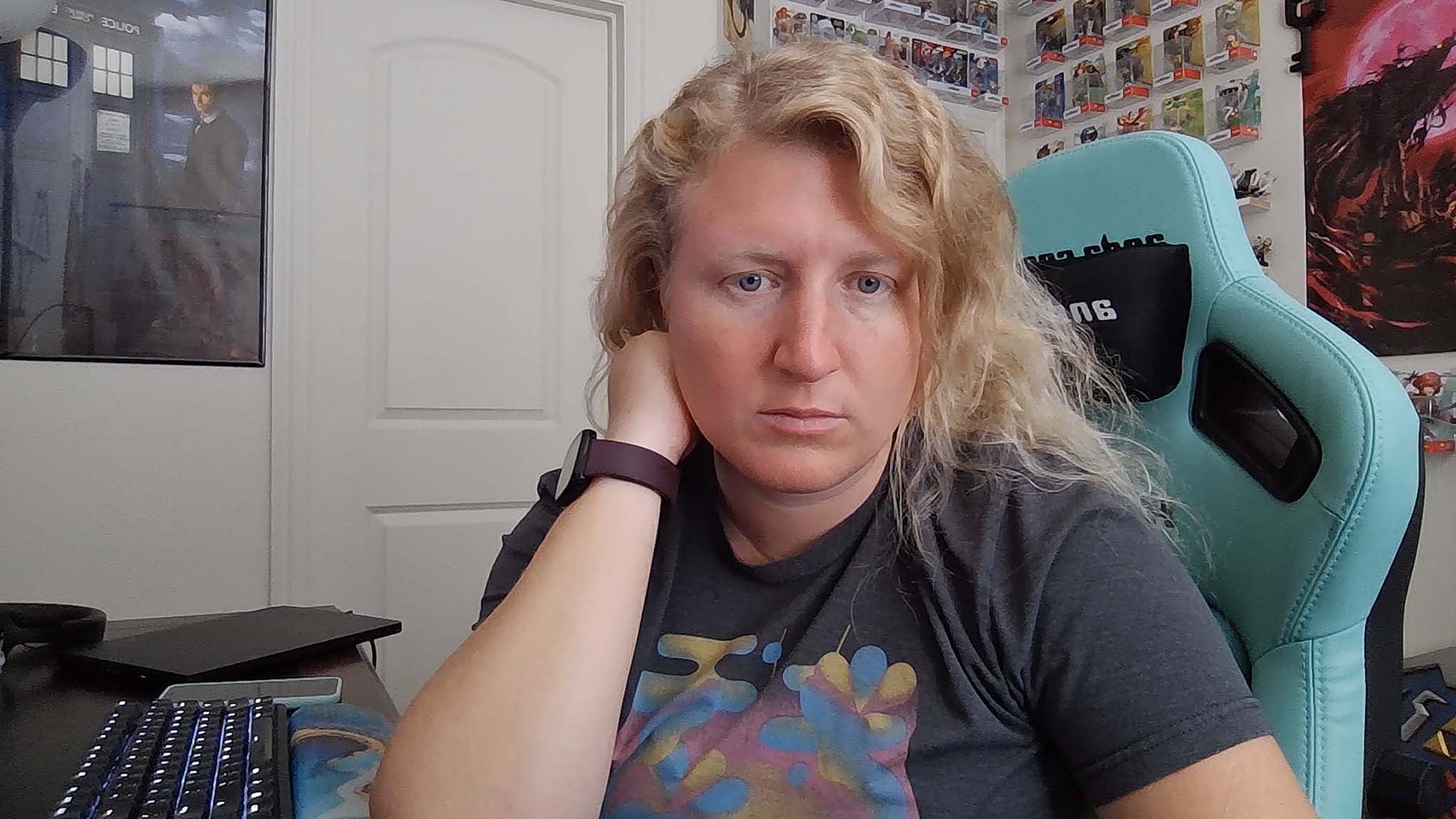
Camera, mic, and speaker highlights
- Colors and details look good on this 1080p FHD camera.
- Windows Hello is supported for face recognition login.
- There is no physical webcam shutter to ensure privacy.
- The speakers offer great audio quality and can get plenty loud.
- Camera, mic, and speaker rating: 4.5/5
The FHD webcam beautifully captures colors and fine details during video calls, making me appear professional. The built-in microphone array equipped with AI noise-cancellation technology ensures my voice is always heard clearly in meetings. Upon initial startup, I easily set up Windows Hello for facial recognition login, which has worked flawlessly since then. Unfortunately, there’s no physical webcam shutter available, not even a digital one to turn it off. Although I prefer a physical shutter for privacy reasons, an adhesive cover can be added as a temporary solution if needed.
This laptop employs Smart Amp Technology in tandem with Dolby Atmos. Positioned on both sides of the keyboard, you’ll find four speakers that include a dual force woofer, all angled upwards. I spent time testing both game audio and music to evaluate sound quality. The speakers are capable of reaching impressive volumes, and they deliver clear mid-to-high tones while also providing a decent bass response.
If you’re after a richer audio experience in music or require high-quality sound effects for your video games, then investing in one of the top-tier PC gaming headsets would be beneficial. Fortunately, the Zephyrus G16 comes equipped with Hi-Res certification, enabling you to utilize some excellent headsets for an enhanced listening experience on your laptop.
ASUS Zephyrus G16 (2024): Competition
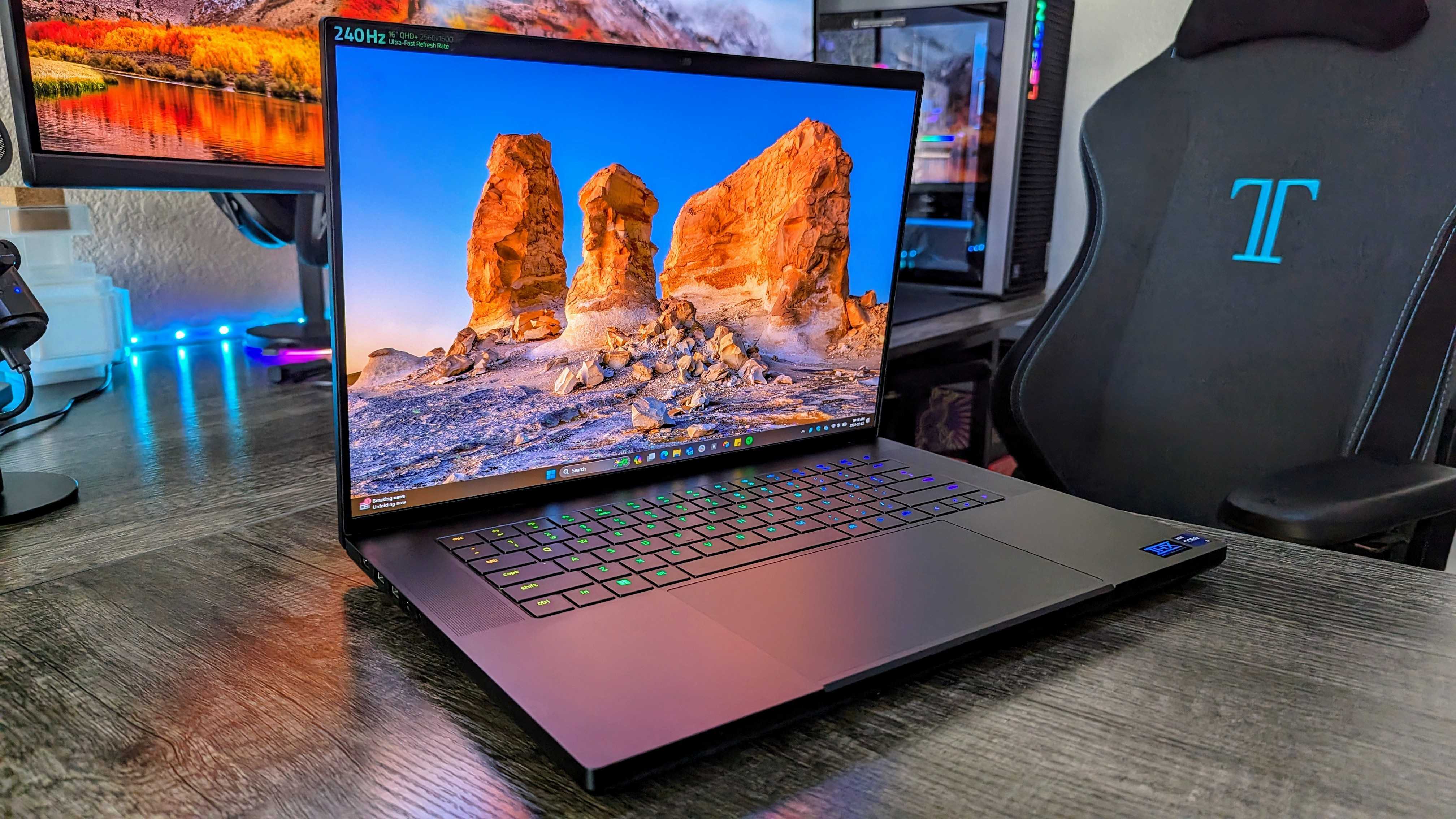
Currently, AI-equipped processors are not common in the laptop market, especially in gaming laptops. In fact, very few gaming laptops incorporate them. Interestingly, most of the AI-enabled gaming laptops available today opt for an Intel CPU rather than AMD. However, the Zephyrus G16 GA605 stands out with its AI processor from AMD, making it a rare find. Due to this scarcity, there aren’t many direct competitors to compare it with, but there are some similar models.
Initially, let’s discuss the Alienware m16 R2 (2024). This model comes with two distinct Intel AI processors and three options for RTX 40-Series graphics cards. The specific model I reviewed for my Alienware m16 R2 critique boasts an Intel Core Ultra 7-155h, an RTX 4070, 16GB RAM, and a 1TB SSD. While the fans can become somewhat noisy, it delivers excellent gaming performance and offers a variety of ports. It retails for $1,999.99 at Best Buy.
Additionally, you might be interested in the MSI Stealth 18, boasting an Intel Core i9-185H processor, an RTX 4080 graphics card, 1TB SSD, and a screen capable of hitting 240Hz refresh rate. In essence, this configuration equates to a potent gaming laptop. Notably, it carries a sizable starting price tag of $3,299.99 on Best Buy.
If you don’t want an AI gaming laptop, then I’ll direct your attention to my colleague’s Razer Blade 16 (2024) review. In addition to its stunning OLED display, this laptop features a 16-inch OLED display while housing a far more powerful RTX 4090 L and an Intel Core i9-14900HX. With these specs, it’s no surprise that it offers better performance than both the AMD and Intel Zephyrus G16 models. It sells for a whopping $4,199.99 at Best Buy.
ASUS Zephyrus G16 (2024): Scorecard
ASUS Zephyrus G16 (2024): Should you buy it?
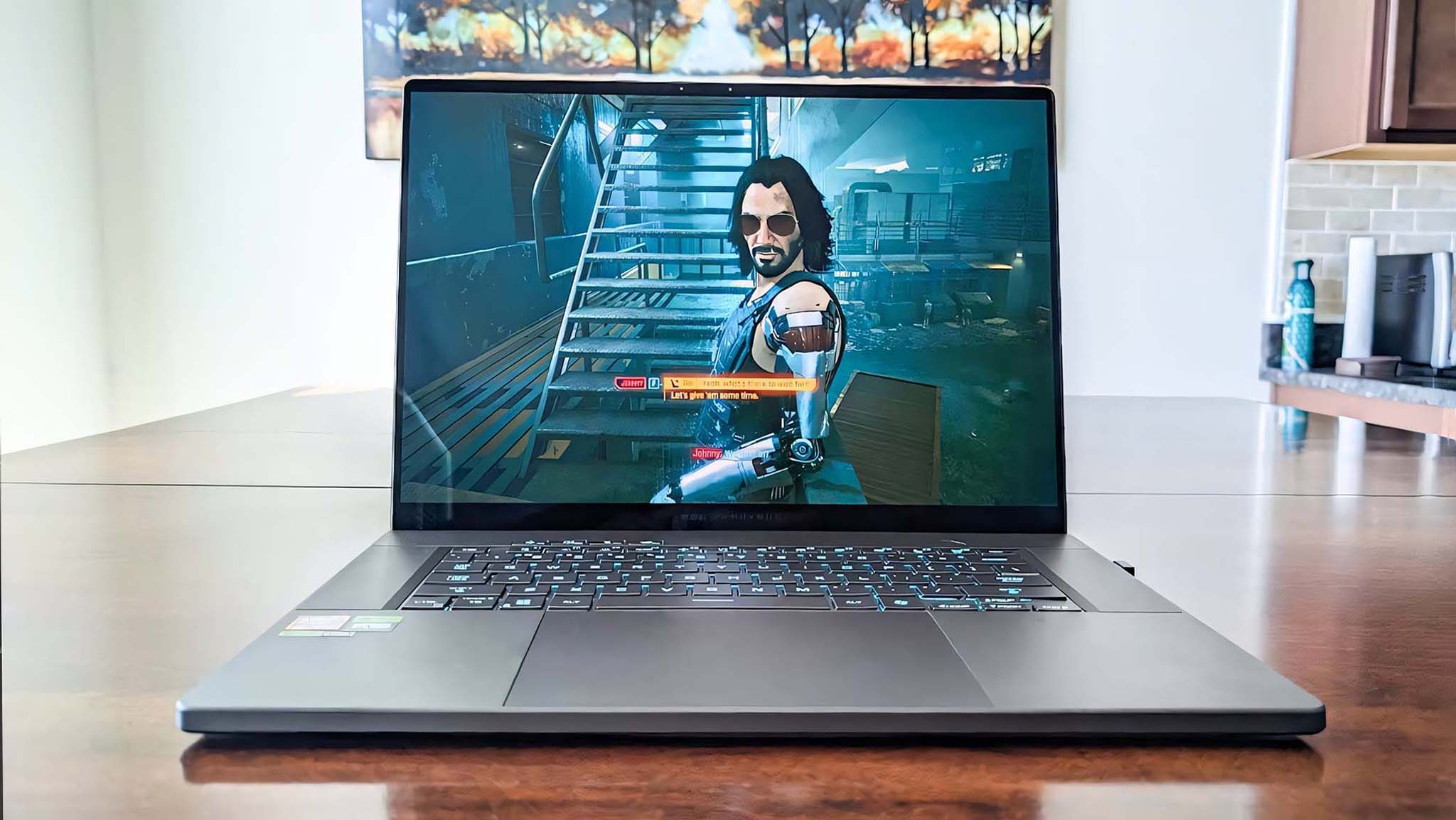
✅ You should buy this if…
- You want a gaming laptop that has a classy design: Most gaming laptops on the market have this edgy look to them or have a lot of flashy RGB that looks out of place in certain scenarios. Meanwhile, the Zephyrus G16, has a far more elegant chassis that looks good in formal and casual settings.
- You’d like an AI PC that can handle gaming: AI CPUs are still relatively new, and they’re more likely to be found in business laptops rather than gaming laptops, which is why the Zephyrus stands out.
- You’re looking for a laptop with a gorgeous OLED display: Thanks to its 16-inch 2.5K OLED panel, the Zephrus G16 displays game visuals beautifully, with amazing color and crisp detail.
❌ You should not buy this if…
- You want a laptop with long battery life: Most gaming laptops on the market have short battery life, especially ones equipped with the most powerful RTX 40-Series GPUs. Typically, laptops with better battery life aren’t as powerful and aren’t the best fit for gaming.
- You need a laptop that has an Ethernet port: It’s honestly baffling to see a gaming laptop without an RJ45 port. If you tend to play a lot of online multiplayers, it’s better to have the option of getting wired internet rather than relying on Wi-Fi. That said, you could fix this by using a USB-C hub that features the missing Ethernet port.
There are plenty of gaming laptops on the market right now, and the latest push has seen them get outfitted as AI PCs and Copilot+ PCs. If you want to keep up with the latest technology, then the ASUS ROG Zephyrus G16 (2024) GA605 is a fantastic choice to go with. The AMD AI CPU is very powerful, outperforming many of the other AI-boosted processors out there. Meanwhile, the inclusion of a RTX 40-Series GPU, G-Sync support, 240Hz refresh rate, and 0.2ms response time allow for some very smooth gaming sessions.
It would be preferable if this AMD laptop model offered more GPU options when customizing, and finding an RJ45 port might prove challenging. Nonetheless, the Zephyrus G16 boasts numerous beneficial features and connections that cater to your requirements. The device’s sophisticated design allows you to use it comfortably in both professional and casual environments.
Read More
- WCT PREDICTION. WCT cryptocurrency
- The Bachelor’s Ben Higgins and Jessica Clarke Welcome Baby Girl with Heartfelt Instagram Post
- Royal Baby Alert: Princess Beatrice Welcomes Second Child!
- Guide: 18 PS5, PS4 Games You Should Buy in PS Store’s Extended Play Sale
- The Elder Scrolls IV: Oblivion Remastered – How to Complete Canvas the Castle Quest
- New Mickey 17 Trailer Highlights Robert Pattinson in the Sci-Fi “Masterpiece”
- AMD’s RDNA 4 GPUs Reinvigorate the Mid-Range Market
- Chrishell Stause’s Dig at Ex-Husband Justin Hartley Sparks Backlash
- SOL PREDICTION. SOL cryptocurrency
- Studio Ghibli Creates Live-Action Anime Adaptation For Theme Park’s Anniversary: Watch
2024-10-03 17:10